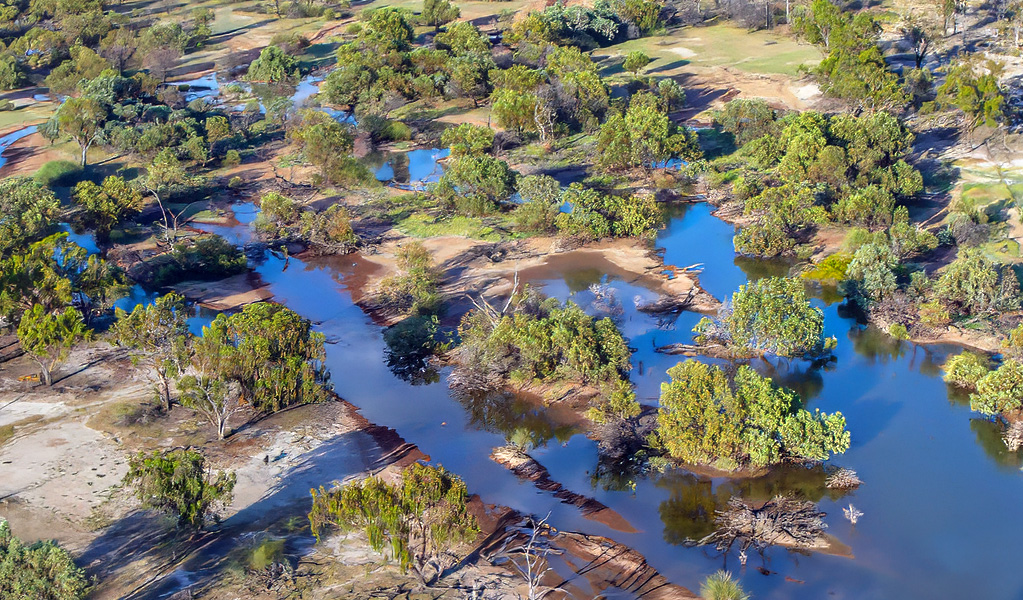Brindingabba National Park
Overview
Brindingabba National Park, about 2 hours from Bourke, bursts with colour. See red kangaroos, green budgies, pink cockatoos and heaps of yellow flowers on a scenic drive, then camp out under the stars.
Read more about Brindingabba National Park
Wildlife is booming at Brindingabba National Park, located near the New South Wales–Queensland border on Budjiti and Kurnu Baakandji Country. You have a good chance of seeing red kangaroos and a huge variety of birds, including emus. You could be lucky enough to spot a brolga with its distinctive orange head.
Arrive by the scenic Hungerford-Bourke Road which is part of the Dowling Track outback driving route through channel country. Then drive around tree-lined creeks, red clay deserts, grasslands, woodlands and the mulga plains of outback NSW.
There are lots of places to stop and train your binoculars or camera on the wildlife, scenery and wildflowers. Woodlands are a haven for birds including rare grey-crowned babblers, Hall’s babblers and mistletoe birds. Among the trees or on the grasslands you could find an echidna foraging among the leaf litter. Stop by a waterhole for an early evening or morning bird watching session and you may see zebra finches and rainbow bee-eaters.
The park is ablaze with colour from late Autumn to early Spring, when yapunyah and lancewood trees have cascades of bright yellow flowers and wildflowers on the mulga shrubland range in colour from lilac and pink to white to reddish brown. Sunsets are often spectacular, and you can vie with your friends as to who can take the best photo.
The park has many Aboriginal cultural items such as wells and stone artefacts. Please keep to marked tracks to avoid disturbing them.
After your outback adventure, pitch a tent at the campground and stretch out on the ground under a carpet of stars.
Local alerts
For the latest updates on fires, closures and other alerts in this area, see https://uat.nswparks.cloud/visit-a-park/parks/brindingabba-national-park/local-alerts
Contact
- in the Outback NSW region
Brindingabba National Park is always open but may have to close at times due to poor weather or fire danger.
-
-
Bourke office
02 6830 0200
Contact hours: Monday to Friday, 8.30am to 4.30pm. - 51-53 Oxley Street, Bourke NSW 2840
-
Email: npws.bourke@environment.nsw.gov.au
-
Bourke office
Visitor info
All the practical information you need to know about Brindingabba National Park.
Maps and downloads
Learn more
Brindingabba National Park is a special place. Here are just some of the reasons why:
Plants and animals protected in this park
Animals
-

Emu (Dromaius novaehollandiae)
The largest of Australian birds, the emu stands up to 2m high and is the second largest bird in the world, after the ostrich. Emus live in pairs or family groups. The male emu incubates and rears the young, which will stay with the adult emus for up to 2 years.
-

Red kangaroo (Macropus rufus)
The red kangaroo is one of the most iconic Australian animals and the largest marsupial in the world. Large males have reddish fur and can reach a height of 2m, while females are considerably smaller and have blue-grey fur. Red kangaroos are herbivores and mainly eat grass.
-

Short-beaked echidna (Tachyglossus aculeatus)
One of only 2 egg-laying mammals in the world, the short-beaked echidna is one of the most widespread of Australian native animals. Covered in spines, or quills, they’re equipped with a keen sense of smell and a tube-like snout which they use to break apart termite mounds in search of ants.
-

Wedge-tailed eagle (Aquila audax)
With a wingspan of up to 2.5m, the wedge-tailed eagle is Australia’s largest bird of prey. These Australian animals are found in woodlands across NSW, and have the ability to soar to heights of over 2km. If you’re bird watching, look out for the distinctive diamond-shaped tail of the eagle.
-

Tawny frogmouth (Podargus strigoides)
Found throughout Australia, the tawny frogmouth is often mistaken for an owl due to its wide, powerful beak, large head and nocturnal hunting habits. The ‘oom oom oom’ call of this native bird can be heard echoing throughout a range of habitats including heath, woodlands and urban areas.
Plants
-

Mulga (Acacia aneura)
Mulga are hardy Australian native plants found throughout inland Australia. With an unusually long tap root, the mulga is able to withstand long periods of drought.
-

River red gum (Eucalpytus camaldulensis)
Australian native plants, majestic river red gum trees are widespread across Australian inland river systems. The river red gum is a dominant tree species of the Murray-Darling basin which spans NSW, Queensland and Victoria. This iconic native eucalypt grows to a height of 30m and is thought to have a lifespan up to 500-1000 years.
Environments in this park
- Desert and arid shrubland environments
- Wetland environments
- Grassland environments
- Woodland environments
What we're doing
Brindingabba National Park has management strategies in place to protect and conserve the values of this park. View the detailed park and fire management documents.
General enquiries
- National Parks Contact Centre
- 7am to 7pm daily
- 1300 072 757 (13000 PARKS) for the cost of a local call within Australia excluding mobiles
- parks.info@environment.nsw.gov.au
Contact
- in the Outback NSW region
Brindingabba National Park is always open but may have to close at times due to poor weather or fire danger.
-
-
Bourke office
02 6830 0200
Contact hours: Monday to Friday, 8.30am to 4.30pm. - 51-53 Oxley Street, Bourke NSW 2840
-
Email: npws.bourke@environment.nsw.gov.au
-
Bourke office

